Pitch Lake

Beez Neez now Chy Whella
Big Bear and Pepe Millard
Tue 20 Oct 2009 20:01
|
La Brea Pitch
Lake
 
 We got up expecting to do a full day
of jobs, but, Jessie radioed that he had a trip to
the Pitch Lake, Temple on the Sea and Hanuman Murti, jobs soon postponed and off
we went. After about an hour of driving and entertaining us Jessie suggested
"doubles", the other six on the bus all jumped at the
chance. So Jessie bought for us all. While he was waiting for us - time for
a quick sweep of his very clean and posh maxi
taxi(we are not allowed to eat on board, except for ice-cream at the end of a
trip if we get our quiz answers correct).
   Two patties of
dough, a couple of scoops of curried chick peas add a little 'hot stuff' and 30p later and in super fast time a double
is ready to eat. Sadly for me Bear went back for a second one - I'll come
back to this after lunch of goat roti. All happily back on the bus heading to
the first proper stop. We loved the directions: From Port of Spain, take the
Uriah and Solomon Highways through to the San Fernando (second and only other
city on Trinidad) Bypass. Take the South Trunk Road through Mosquito Creek. Then
take the Southern Main Road through Otaheite, Aripero, Rousillac and then into
La Brea. Follow signs to the Pitch Lake.
 
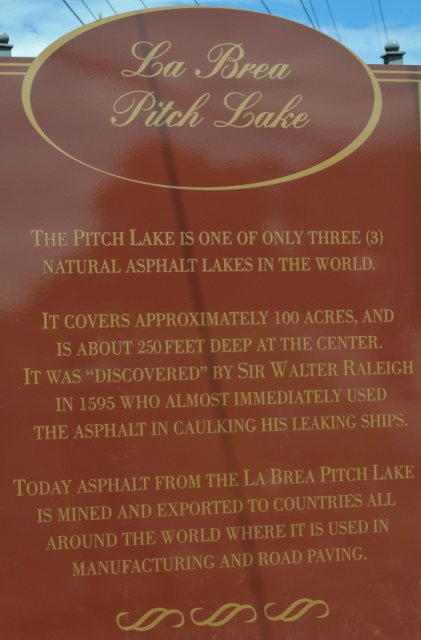 We were welcomed by our guide Ameena, knowing Jessie would take a hundred phone calls and
try unsuccessfully to 'catch forty winks' off we went with our
guide.
The Pitch Lake has been called many
names by numerous settlers in Trinidad. It was called Piche by the Amerindians -
meaning pitch. The Spanish called it Tierra de Brea which means Land of Pitch
and the English referred to it as Pitch Lake. Sir Walter Raleigh, in March 1595,
during his search for El Dorado, he reportedly used the pitch from here as
caulking for his leaking ships and declared it "most excellently goode". The
first records of its introduction to Europe was in 1617, on Raleigh's
second attempt to find El Dorado, he took samples back to
England.
Several Amerindian legends surround
the birth of the Pitch Lake. According to one folk tale, the Lake was a
punishment from the Gods. This vengeance was dealt to the Chaima Indians who
cooked and ate humming birds, which were considered sacred, while celebrating a
victory over another tribe. This so angered the Gods who caused the earth to
open up and swallow the entire village, leaving in its place molten pitch. As if
to prove the legend true, Amerindian pottery has been recovered from the lake,
the odd human skeleton, bones from the giant sloth and a Mastodons tooth. The
humming bird can be seen fluttering around the lake........
 The lake
may not look much from the car park but we knew this was one of only three
natural asphalt lakes in the world.
The Pitch Lake is the world's largest
commercial deposit of natural asphalt. It was re-discovered in 1595 by Sir
Walter Raleigh who repaired his ships. It covers approximately one hundred acres
and is about two hundred and fifty feet deep at the centre. The lake holds about
ten million tonnes of asphalt, geologists have surveyed the area and ninety
tons can be "harvested" or mined every working day allowing the renewable
reserve to last for about the next four hundred years.
 Ameena pointed to the little hut with the green roof. This was the telephone
exchange box that used to be level with the road next to the telegraph poles
when it was built in 1976. Some years ago over harvesting of the pitch lake
caused the level to drop dramatically and the surrounding area has become
unstable.
 We had arrived during the workers
lunch break - 11 'til 12, some were resting in the shade of one of
the cashew trees that line the path to the lake.
The trees grew from seeds thrown by workers generations ago.
In 1792, Governor Jose Maria Chacon
of Spain was orderred to set up a refinery near the pitch lake so that the
refined pitch could be sent to Spain. This was a short lived industry as Spain
lost Trinidad to the English in 1797, the Spaniards were forced to leave the
island leaving only their name for the area - La Brea. In 1805, the British
Admiral Alexander Cochrane was asked to examine and report on the Pitch Lake, he
reported that the pitch had to be mixed with "tar and oil before it became
useful". In 1888 the British Government awarded a single concession to mine
the Pitch Lake to an American A. L. Barber - together with several other
businessmen, formed the Trinidad Lake Asphalt Company.
   Around the edge of the lake itself the
pitch contains 30% water, 30% minerals and the rest Bitchumen. Sulphur stains make for pretty colours. Bear cooling his feet.
Methane bubbles where the lake "breathes".
There have been countless conflicting
theories on the origin of the Pitch Lake. One such theory states two faults
exist which intersect at the lake and that crude oil seeps from the fault line
in the limestone below the earth. Another belief is that the lake was at one
time a huge mud volcano from which muddy asphaltic oil seeped. The lighter
portion of the oil and mud mixture evaporated over centuries and left the thick
viscous residue - asphalt - which is what we see today. Our outing gave us
the impression we were walking on a living thing. It burps, hisses and consumes
everything around it.
   We saw a tree
stump that had risen to the top. Ameena poked her
finger through the surface to show how soft it is and we peeled back an area of crust to expose the purer soft
pitch.
"Numerous pieces of wood which, being
involved in the pitch, are constantly coming to the surface... Whence do they
come? have they been blown on to the lake, or left by man? or are they fossil
trees, integral parts of the vegetable stratum below which is continually
rolling upward?... Stranger still it did seem to us, when we dipped our hands
into the liquid pitch, to find that it did not soil the fingers... It can be
scraped up, moulded into any shape you will... but nothing is left on the hand
save some gray mud and water. This very abundance of earthy matter it is which,
while it keeps the pitch from soiling, makes it far less valuable than it were
it pure". (Charles Kingsley, 1871)    Walking a bit further we were shown
that just below the ordinary looking surface was really liquid pitch that acts
like quick sand if you stray over it, this makes the lake potentially
dangerous, meaning you have to follow exactly where your guide leads. Bear had a dabble. We walked over deep
cracks and seams. Most of the lake is
solid enough to walk on except for the area in the centre of the lake known as
"the Mother of the Lake". This is the self replenishing part that is always
active. Ameena poked a stick into one of the cracks below water and came up with
more liquid pitch. In 1959 a worker was sucked down
to chest height and was lucky to survive the experience.
 The processing
factory.
Every day the mined pitch is taken to
the processing factory to be purified. For every one hundred and eighty tons
that go into the red silo - one hundred and forty two tons comes out pure. The
pitch is heated to one hundred degrees centigrade to burn out the
impurities. The factory is very proud that the area in front of the gates of
Buckingham Palace came directly from this Trinidadian wonder. England and
Germany used to be the biggest customers but now Japan and China outbuy - they
request their purchases to arrive in pellet form in sacks.
   Ameena took a picture of us. The area of highest visible sulphur is where people
come to bathe to soothe arthritis, skin conditions
and rheumatism. The tracks of the vehicles cut into
the soft surface prove they must keep moving or risk sinking into the
pitch.
 
     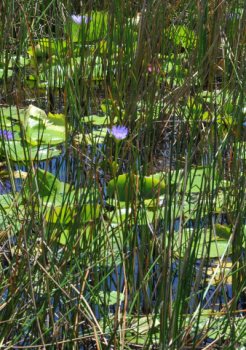
 The area makes for some very different pictures, we saw turkey vulture, white ibis,
green backed heron, many dragonflies, butterflies, stunning blue water lilies
and interesting landscapes. The area had that wonderful smell of newly laid
road, until you got too close to the sulphur pong - thankfully not too much of
the rotten egg compared to the pitch.
  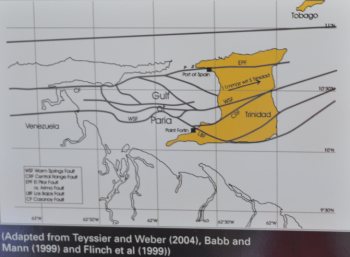 Time to look around the newly opened museum that is above the very smart
'restrooms'. The origins of the asphalt deposits of the Pitch Lake date back to
the Barremian age in the early Cretacious period - circa 121-127 million years
ago. Gases, oils and water were chemically separated from the rock material, and
folding movements of the earth's crust resulted in asphaltic viscous oil to flow
onto the muddy sea floor, where it mixed with plant and other mineral matter as
well as water. Due to the viscosity, this mix held together and gradually formed
an inverted cone. After it had grown about two thousand feet, it is assumed that
this cone was buried and not much seepage of the viscous oil took
place.
 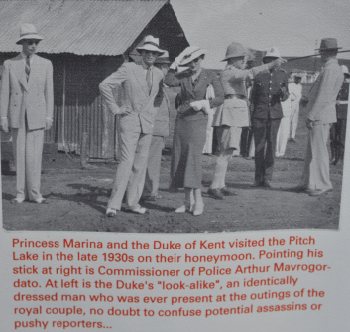  In 1838, two ships chartered by R.T.
Claridge formed probably the first substantial cargo of pitch in Trinidad's
history. Great Britain imported large amounts from this lake in the first half
of the 19th Century, mainly to improve the "macadam" roads, turning them into
"tarmacadam" or "tarmac" through the application of pitch.
The blind Scotsman John Metcalfe had
been the first in the world to implement asphalt on roads in 1717 when he built
180 miles of roads in Yorkshire. In 1757, another Scotsman Thomas Telford
perfected the method of road building with broken stones. In that same year, a
third Scotsman called John McAdam, designed roads using broken stones laid
very tightly and evenly, forming a harder surface. These were the famous
McAdam roads, they were more economic than the Telford design and became the
norm. In 1813 the Port of Spain built many macadam roads. Hot tar was used in
England as early as 1820.
In a letter to the Earl of Dundonald,
dated the 25th of April 1857, Conrad Frederick Stollmeyer reported that "Dr
Philbricks's Company, associated with Hiram Hyde of Halifax, Nova Scotia and
Samuel Dower of Boston, also makes oil from pitch...and give specific name to
the oil... 'Trinidad Oil'... Philbrick et al wish to make the oil in
Boston.
Born in 1813 in the ancient city of
Ulm, Germany, Conrad Stollmeyer migrated to the US in 1833 and came out to
Trinidad in 1845 on his way to Venezuela. However, he was persuaded to stay in
Trinidad, where he became interested in the possibilities of asphalt. From 1849
onwards he looked after the Earl of Dundonald's holdings at La Brea, digging
asphalt from the Pitch Lake and shipping it to the US and Europe for the
manufacture of the newly invented Kerosine, which was then named "Trinidad
Oil".
  Conrad
Stollmeyer, Lord Dundonald and Abraham Gesner
Gesner distilled his first kerosine
from La Brea pitch, which he obtained from his friend Thomas Cochrane, 10th Earl
of Dundonald, then the licensee to mine the lake. Kerosine was revolutionary. It
changed history and quickened the march into modern times. Pitch from this lake
became the raw material for the first modern petrochemical product - Kerosine.
Home and street lighting on a very wide scale was introduced to the town of Port
of Spain and to outlying districts and villages, causing an upgrade of social
life and more security. Kerosine also improved family life, used in lamps and
stoves, it brought a better standard of living for all, especially the poor.
During the cholera epidemic the burning of pitch in barrels at street corners
was erroneously thought to be a preventative for the disease, which was believed
to be air-borne. Pitch was experimented with as a fertiliser because it was
thought to be the reason for this areas particular fertile land. While the
energy sector in Trinidad never employed more than a couple of thousand people
at any point in time, its existence fostered a culture of education among
Trinidadians. Pitch, oil, natural gas and petrochemicals required
university-trained engineers and scientists as well as skilled white and blue
collar workers.
  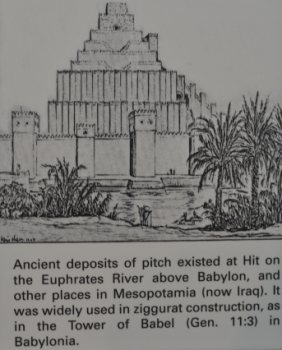 Pitch was used as
a sealant to cover the reed basket in which the baby Moses was concealed
among the reeds of the Nile Exodus 2:3. Pitch in Antiquity.
The Tower of Babel.
The Giant Sloth (glossotherium
harlani) standing in excess of fourteen feet would have lumbered through the
ancient woods of Trinidad in times past. Indeed, its huge bones, described
as fossils, have been found here. Folklorist Honore Ernest Tardieu who died in
1969 has suggested that the memory of this huge, awesome but bovine creature may
have been passed along in stories and songs of the ancient tribal peoples, who
made their home here. This, Monsieur Tardieu suggested, might have given rise to
the myth of Maitre Bois, the Master and Father of the Forest, Papa Bois, who is
described as a huge, hairy creature. The character Papa Bois as protector of the
animals was written by the folklorist Alfredo Codallo in
1954.
   As we drove away from the site toward
our roti lunch, we saw the damage to roads and
houses caused by the shifting pitch. Oozing
additions to the gardens in the area.
ALL IN ALL - FASCINATING.
IT WAS STRANGE TO WALK ON WHAT FELT LIKE SPRINGY
SPONGE
|